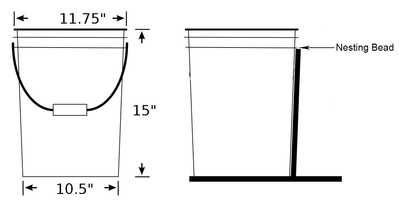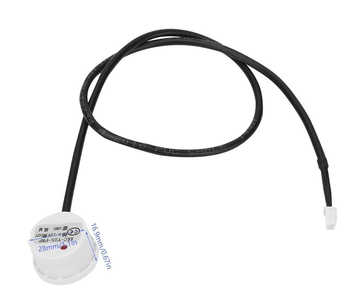My current pump setup has some type of pressure device following the pump and when there is no pressure/water for say 20 seconds it shuts off. This is managed through what the pump manufacturer calls a "Smart Box". This new system will need similar logic, for sure!
That sounds like it will keep the pump safe, anther problem off the list 🙂
Anything seems possible when you don't know what you're talking about.
That chart doesn't seem to give any actual measurements. The first two columns are heights in inches and centimetres, the second pair is just the first two columns with 2% added and the third pair is the first two with 2% subtracted. The final column is the difference between %2 and -2%.
There doesn't seem to be any real measured results displayed, so I don't think the chart is useful.
Also, the author doesn't know what FS means, so the origin of the 2% used as a range is somewhat questionable as well.
The chart is one that I created and just to simply see what a 2% accuracy range would mean at different points throughout tank depth. I don't think, not sure though, inaccuracies would be exactly consistent. For sure we will need actual measurements and I am now wondering and contemplating how to use my piece of 4" pipe and fill with water to various levels and get some real tests.
From what I've read water pressure is purely a function of depth and nothing to do with volume. In other words the pressure of water at 2' 61cm is the same in the ocean and a small tank. Is a 4" PVC pipe enough? Don't know.
Guess I could use one of my tanks, but it's winter now and playing with water outside is uncomfortable. BUT if it has to be it has to be. Then there is always the bathtub! Not too deep but it is 18" 43cm.
From what I've read water pressure is purely a function of depth and nothing to do with volume. In other words the pressure of water at 2' 61cm is the same in the ocean and a small tank. Is a 4" PVC pipe enough? Don't know.
That's true. You know that instinctively because you know that the water level in your 4" stack will be exactly the same as it is in the tank. Now imagine that you dig deeper and put in a longer stack with another 10' of length below ground, you know that the water level in the tank and in the extended pipe will STILL be the same.
So, water pressure increases as you move lower in the water because the pressure is generated by the weight of the water ABOVE and is unaffected by being pushed in from the sides or the bottom.
Anything seems possible when you don't know what you're talking about.
This may be limited in interest but I'd like to be able to sense the presence of water through a plastic tank. I attempted it with limited success but have not given up yet.
I am very interested in this topic but have to apologize to you for somehow hijacking your thread. This happened partially since a thread I started "Introducing Myself with my irrigation project" is working at how to measure water in storage tanks. This thread you started appears as a possible solution. Somehow though the discussions went astray into all sorts of water level measuring techniques. This just muddies p the waters for the problem you are trying to solve.
All I can say is sorry and that I have taken action to stop posts about my thread ending up in yours.
@wamagee No worries. I find it all interesting. I'm anxious to give my project another shot when I find some time. I still would like to sense the water level from outside the tank. My situation is the tank gets removed often for cleaning but is returned to the exact same spot so having something inside with wires attached would just make an extra step for removing it to clean. The ultimate would be if I have sensors that the tank sits against but are not physically attached to the tank. BTW, the "tank" is just a 5-gallon bucket with a lid if that matters.
You are welcome to hijack my threads anytime. 😊
The ultimate would be if I have sensors that the tank sits against but are not physically attached to the tank. BTW, the "tank" is just a 5-gallon bucket with a lid if that matters.
Do you perceive something like this image where I have the 5-gallon bucket sitting on a stand of some sort with a slanted vertical piece that would hold your sensing device(s)? Nothing attached to the bucket.
Then do you need measurements above the Nesting Bead? This image shows the Nesting Bead a somewhat small distance from the top and most 5-gallon buckets I am familiar with seem to have their Nesting Bead further down. And this will matter if you need to detect liquid above the Nesting Bead.
Maybe we can use this image to start Brainstorming solutions.
Some other stuff:
This video seems to demonstrate that Capacitive Sensors do not have to touch the container, so that is encouraging.
And this video that @byron found
https://www.pjrc.com/teensy/td_libs_CapacitiveSensor.html
Speaks to turning copper strips into Capacitive Sensors
Here is a YouTube video that demo's the above:
And here is another that walks you through step by step of building a Capacitive Sensor using a copper strip. I found this one interesting:
And you might be able to insert these sensors into the slanted vertical piece:
So here's to keeping your thread about your topic, it will make it easier to follow and therefore more informative to all that are interested!
@wamagee This is exactly what I need. No need to detect above the nesting bead. Thank you for this info. I hope to dive into it soon and will report back what I find. 🙂
This is exactly what I need. No need to detect above the nesting bead. Thank you for this info. I hope to dive into it soon and will report back what I find
If there something that I think might help I'll toss it your way. And I will be thinking on it!
I am assuming that something is pulling from this bucket. Do you need to determine when the liquid falls to a specific level? Or just to a few specific levels.
OR, are you just as interested in playing/learning as solving the problem and would like to get continuous sensor readings? I myself have a serious, has to be done, problem to solve but really enjoy the learning and playing. Gotta be careful that the wife doesn't come to the conclusion that I am playing and having more fun than working on the problem.
Often when getting new tools I slip and call them toys. Getting out of that one is really tough. Toys/Tools synonyms, correct? 🙂
@wamagee I only need like 2 or 3 level indicators. This is for a recirculating shower in my RV. I boondock and still want my long hot showers so I've built a system where I flip a switch and the drain switches to the bucket. From there it goes through several filters and a UV light to kill any bacteria, then through a heat exchanger connected to the water heater then back to the shower. However, there is loss from steam and drying off when getting out so the water level gradually goes down. Then there are the times I clean the system and refill. The bucket is in an area that is not easy to see so I'm often guessing on how much water I need to replace. The goal is to have indicators in the bathroom to easily tell when it is getting low or high. Thank you for all your input!
This is for a recirculating shower in my RV. I boondock and still want my long hot showers
Ask and you shall receive.
My wonderful wife watches many YouTube Channels on RVs. She lives for long showers. She wants an RV with a continuous hot shower. The only RV she has seen so far that has a continuous shower is one called "The B-Box". It starts with a basic shell and is custom from there and starts at $350,000. We are not buying one unless we hit the Lotto.
I think the B-Box goes through a simiular cycle as you defined above "it goes through several filters and a UV light to kill any bacteria, then through a heat exchanger connected to the water heater then back to the shower"
But, I will use this to my advantage! If I tell her someone is building a recirculating RV shower on this forum she will ask for regular updates and more easily overlook the time I spend on this forum. Conniving? Yea, but we won't tell anyone. Big Secret!
But, I will use this to my advantage! If I tell her someone is building a recirculating RV shower on this forum she will ask for regular updates and more easily overlook the time I spend on this forum. Conniving? Yea, but we won't tell anyone. Big Secret!
Sneaky devil 🙂
Anything seems possible when you don't know what you're talking about.


